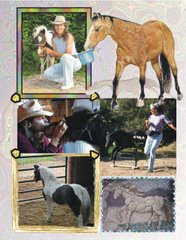One of the most obvious statements I could make about a move is that things change. Things look different, stuff gets put in different places; doors, gates, the color of the stall walls and even plants/shrubs are different.
What is also obvious, but maybe more significant, is how the changes in our environment make us adjust our routines. I watch myself doing things out of habit, in fact sometimes it's downright amusing. For example, part of the fencing was taken down on the back side of the barn and subsequently was only partially connected to a fence line. The other portion led right into the pasture. So on and off for that day I reached to unlock the gate to go through it, before finally adjusting to go the extra 6 steps right into the open pasture. I find that a bit amusing, but then I think of how the change affects the horses and their habits.

For example, Buckwheat has had a feeding ritual where, once he sees me, he backs away from his gate, makes a 180 turn, then walks over to his platform to politely stand and wait. I've even posted a short video showing this nice behavior chain.
Now his temporary paddock is in a different location. It is at a 90 degree angle to its former orientation, facing north instead of west, about 75 yards from its former spot. How did this affect him? As I walked to his paddock, he didn't even think about backing up for his dinner. His pen was different. The context of his behavior was obviously very hooked into the surrounding visual cues; my presence was only part of what triggered the behavior. So this behavior was learned and practiced in a specific location, and it had not been generalized beyond that location.

This change in Buckwheat really serves as a great reminder. If we can count on things remaining the same, for a simple behavior like a dinner ritual, we might not need to go to the effort to generalize it to different places, but if we have important riding or safety behaviors, this generalization process is critical. We can't assume the horses understand a behavior without testing it by moving to a variety of new places or locations in which we ask for the behavior. If we DO try to ask for untested cues, it sure isn't fair to the horse to be upset with him if he doesn't get it.
So I have re-started the process of shaping the dinner dance. It's interesting to see how Buckwheat is responding. At first, he began to paw as I approached his gate. The change of his pen placement obviously was different enough for him that he was more anxious about getting his dinner. I ignored the pawing the first time until I got to the gate, then actually cued him to back (before, this was all a part of the chain and did not need to be cued).
The next meal I stopped short of the gate, then paused. He offered a step back, to which I responded by stepping forward. He stopped, so did I, he backed again, so I continued forward. I should mention that we've trained "Buckwheat can make Peggy's feet move" in the past; it is not a new way of training with him.
The process of rebuilding his meal time stationing behavior will progress quickly, I'm confident in that. It is one of the good things about training with positive reinforcement; the behaviors are built on repetition can be re-built.






No comments:
Post a Comment